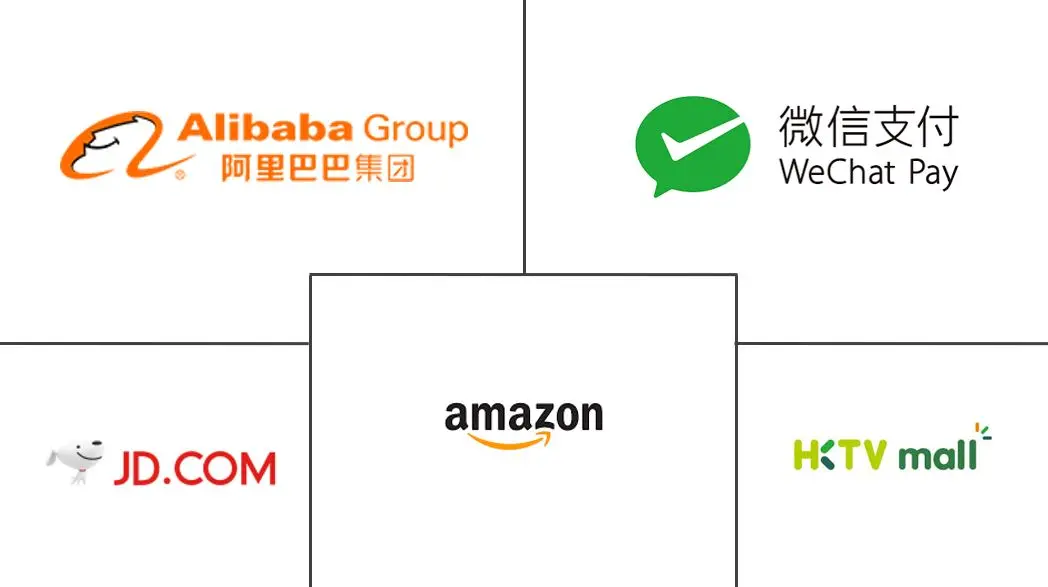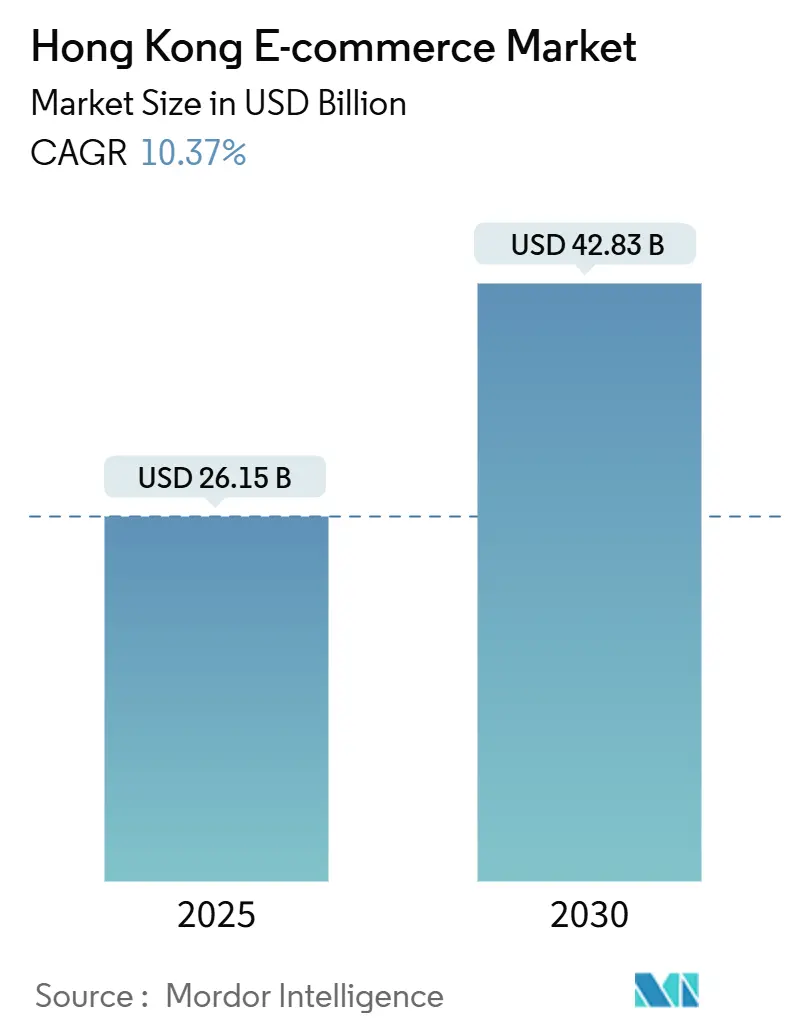
Hong Kong E-commerce Market Analysis by Mordor Intelligence
The Hong Kong e-commerce market stood at USD 26.15 billion in 2025 and is projected to advance to USD 42.83 billion by 2030, reflecting a 10.37% CAGR over the forecast period. Continuous gains arise from the territory’s role as a springboard between mainland China and international buyers, its 95.6% internet penetration, and its 93.9% mobile-access rate.[1]Commerce and Economic Development Bureau, “LCQ8: Developing the cross-boundary e-commerce industry,” cedb.gov.hk Cross-border activity already delivers 55% of total online sales, while government digital-funding schemes accelerate SME migration, and 5G coverage sustains a mobile-first consumer mindset. Mainland platforms are enlarging their presence, intensifying rivalry and prompting investment in purpose-built logistics such as the 380,000 m² Cainiao Smart Gateway.[2]Cathy Chung & Shi Chun, “Smart Logistics Firm Uses Hong Kong to Connect with Mainland and Overseas Markets,” research.hktdc.com The payment landscape is equally dynamic: credit and debit cards hold 45% transaction share, yet digital wallets are expanding at 16.3% CAGR, encouraged by WeChat Pay HK and AlipayHK adoption by more than 85% of residents.
Key Report Takeaways
- By business model, the B2C segment led with 80% of Hong Kong e-commerce market share in 2024, whereas B2B is forecast to post the fastest 12.1% CAGR through 2030.
- By device type, smartphones captured 70% share of the Hong Kong e-commerce market size in 2024 and are on course for a 12.5% CAGR to 2030.
- By payment method, cards retained a 45% share of the Hong Kong e-commerce market size in 2024, but digital wallets are projected to rise at 16.3% CAGR to 2030.
- By B2C product category, fashion accounted for 24% revenue share in 2024, while food & beverages is projected to expand at a 15.5% CAGR to 2030.
Hong Kong E-commerce Market Trends and Insights
Drivers Impact Analysis
| Driver | (~) % Impact on CAGR Forecast | Geographic Relevance | Impact Timeline |
|---|---|---|---|
| Growth of Mobile-First Shoppers Fueled by 5G Roll-out & 99% Smartphone Penetration in Hong Kong | +2.5% | Hong Kong, with spillover to Greater Bay Area | Medium term (2-4 years) |
| Accelerated Cross-Border Fulfilment via Greater Bay Area Logistics Corridors | +1.8% | Hong Kong and Greater Bay Area | Medium term (2-4 years) |
| Government Digital Funding Schemes (D-Biz, E-commerce Easy) Boosting SME Online Migration | +2.1% | Hong Kong | Short term (≤ 2 years) |
| High Credit-Card & E-Wallet Usage Enabling Frictionless Checkout | +1.4% | Hong Kong | Short term (≤ 2 years) |
| Rising Affluence of Gen Z & Mainland Tourist Spend on HK Platforms | +1.2% | Hong Kong, with impact from mainland China | Medium term (2-4 years) |
| Live-Streaming & Social Commerce Monetisation Partnerships with KOLs | +0.9% | Hong Kong | Short term (≤ 2 years) |
| Source: Mordor Intelligence | |||
Growth of Mobile-First Shoppers Fueled by 5G Roll-out & 99% Smartphone Penetration
Mobile commerce already contributes 57% of Hong Kong e-commerce market transactions and is forecast to climb to 65% by 2027 as 5G enables richer media and near-instant page loads. Retailers are redesigning storefronts for thumb-friendly navigation, launching app-exclusive flash sales, and leveraging higher-definition livestreaming for fashion and beauty lines. These actions translate into larger basket sizes and shorter purchase cycles, reinforcing the strength of the Hong Kong e-commerce market among all age groups.
Government Digital Funding Schemes Boosting SME Online Migration
Programs such as “E-commerce Easy” under the BUD Fund permit grants up to HKD 1 million (USD 128,000) per firm, with nearly 1,000 approvals in the first half of 2024. These subsidies lower entry barriers for legacy sectors and accelerate digitization of procurement and customer engagement. Participating merchants report swifter storefront launches and enhanced access to mainland buyers through bilingual interfaces, delivering broad-based lift to the Hong Kong e-commerce market.
Accelerated Cross-Border Fulfilment via Greater Bay Area Logistics Corridors
The April 2025 inauguration of the China–Europe Railway Express e-commerce line slashed transit times to Europe by more than 50% versus sea freight and cut costs by one-fifth compared with air.[3]China Inspection and Quarantine Times, “The Guangdong-Hong Kong-Macao Greater Bay Area launches the …,” cceeccic.org Logistics absorption in the GBA reached 2.35 million m² in 2023, underpinned by Temu, Shein, and TikTok Shop growth. Faster shipping directly raises conversion rates for electronics and fashion exports, cementing Hong Kong’s status as a preferred fulfilment node within the Hong Kong e-commerce market.
High Credit-Card & E-Wallet Usage Enabling Frictionless Checkout
Card acceptance remains ubiquitous, yet wallet penetration exceeding 85% is pushing merchants toward multi-rail payment stacks. The Faster Payment System now links 36 banks, supporting nearly 15 million registered accounts. Frictionless checkout contributes to lower cart abandonment and fosters average-order growth, especially for cross-border shoppers who can settle instantly in native currency.
Restraints Impact Analysis
| Restraint | (~) % Impact on CAGR Forecast | Geographic Relevance | Impact Timeline |
|---|---|---|---|
| Sky-High Warehouse Rents and Last-Mile Labour Costs Compressing Margins | -1.3% | Hong Kong | Long term (≥ 4 years) |
| Saturation of Marketplace Advertising Driving Customer-Acquisition Costs | -0.8% | Hong Kong | Medium term (2-4 years) |
| Persistent Consumer Concerns over Product Authenticity on C2C Channels | -0.7% | Hong Kong, with impact from mainland China | Medium term (2-4 years) |
| Talent Shortage in Data & Growth-Hacking Roles for E-commerce Operations | -0.6% | Hong Kong | Short term (≤ 2 years) |
| Source: Mordor Intelligence | |||
Sky-High Warehouse Rents and Last-Mile Labour Costs Compressing Margins
Industrial vacancy in Hong Kong’s core districts fell to 4.1% by end-2023, driving the logistics rental index up 2.5% year-on-year. Pure-play retailers face elevated fixed costs, forcing them to split inventories between Hong Kong micro-fulfilment spaces and larger GBA facilities. Smaller sellers struggle to justify automation investment, which can erode cost competitiveness within the wider Hong Kong e-commerce market.
Saturation of Marketplace Advertising Driving Customer-Acquisition Costs
HKTVmall’s 2024 loss of HKD 66.7 million (USD 8.55 million) despite revenue growth exemplifies margin pressure from rising ad bids. Mainland heavyweights such as JD.com intensify competition for search and banner inventory, prompting mid-tier merchants to pivot toward retention, private-traffic channels, and loyalty programs to sustain profitability.
Segment Analysis
By Business Model: Digital B2B Uptick Reshapes Procurement
The B2C channel owned 80% of Hong Kong e-commerce market share in 2024 thanks to consumer familiarity with fast delivery and diversified payment methods. Yet the B2B corridor is accelerating at a 12.1% CAGR through 2030, supported by the Digital Commerce Three-Year Action Plan that incentivizes enterprise marketplaces. Electronics and fashion wholesalers increasingly favor online catalogues and RFQ dashboards, cutting sourcing lead-times while expanding supplier scope.
Momentum in B2B is altering supply-chain negotiation, with most buyers now preferring digital channels for initial vendor discovery. Unified trade-finance APIs and escrow services further de-risk large ticket orders. These developments enlarge the Hong Kong e-commerce market by diversifying revenue beyond consumer spend and embedding platform services into corporate workflows. The Hong Kong e-commerce industry consequently records deeper integration between logistics, payment, and customs data layers.
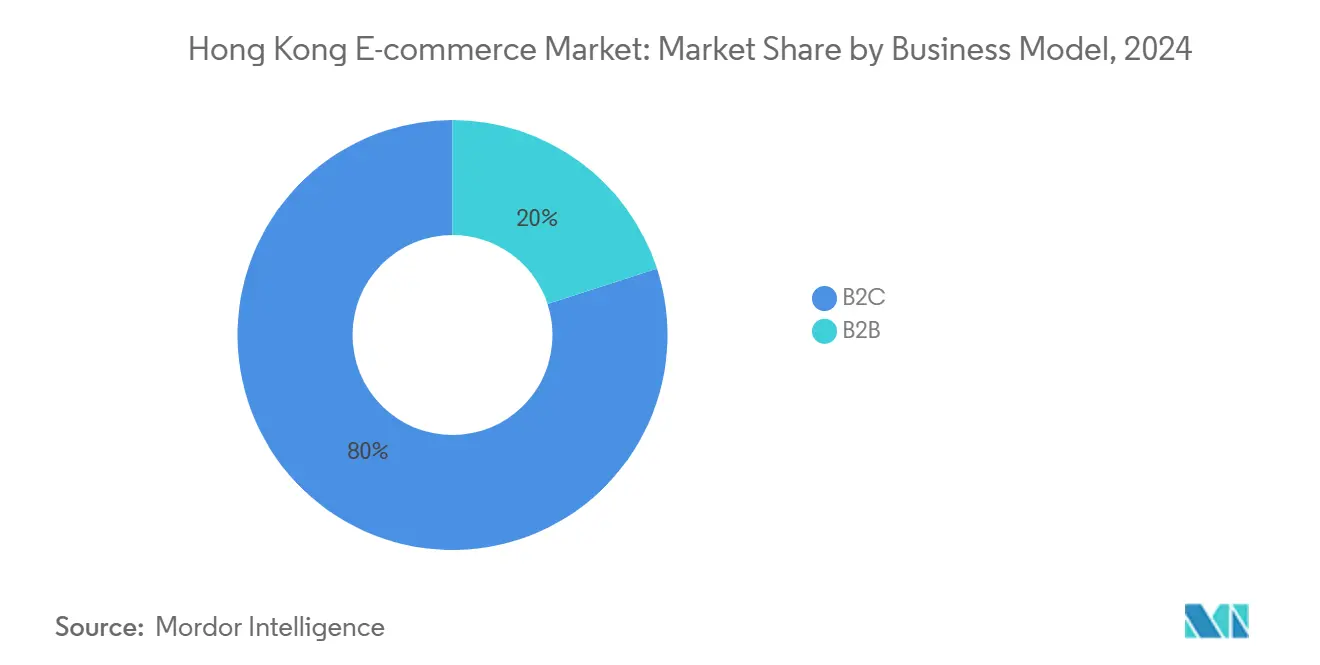
By Device Type: Smartphones Cement Channel Primacy
Smartphones processed 70% of transactions in 2024 and are climbing at 12.5% CAGR, outpacing every other device category. This supremacy reflects commuter convenience, high 5G coverage, and seamless biometric payment authentication. Desktops remain relevant for enterprise procurement that demands richer spec sheets, while tablets and smart TVs represent long-tail touchpoints.
Retailers now launch mobile-exclusive loyalty tiers and leverage push notifications to rebuild visit frequency. ‘Shop-now’ links embedded in TikTok or Instagram posts shorten the decision loop, a shift that continues to propel the Hong Kong e-commerce market. The Hong Kong e-commerce market size for smartphone traffic is forecast to widen its gap over desktop sales through 2030.
By Payment Method: Wallets Rapidly Narrow Card Lead
Cards still retain a 45% slice of the Hong Kong e-commerce market size owing to entrenched trust and rewards programs. Wallets, however, compound at 16.3% annually as WeChat Pay HK and AlipayHK extend cross-border capability up to HKD 400,000 (USD 51,200) yearly for verified users. FPS rail interoperability adds further impetus by enabling near-instant bank-to-wallet transfers.
Merchants offering three or more payment types register higher conversion, and Buy-Now-Pay-Later schemes gain traction for mid-priced electronics. These options broaden the Hong Kong e-commerce market and mitigate single-provider risk. The Hong Kong e-commerce industry is therefore set to showcase one of Asia’s most plural payment portfolios by 2030.
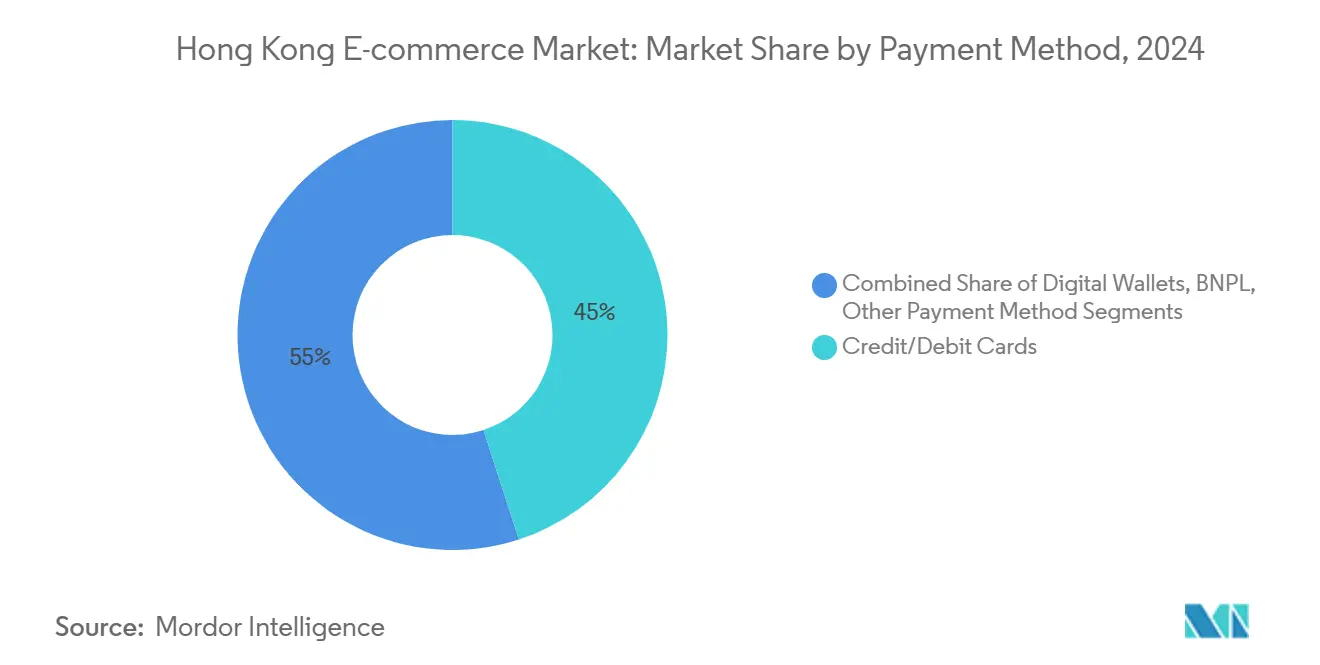
Note: Segment shares of all individual segments available upon report purchase
By B2C Product Category: Food & Beverages Outpaces Fashion
Fashion led 2024 spending with a 24% slice, anchored by Hong Kong’s reputation as a trendsetter and rapid fulfilment of returns. Yet online grocery and beverage sales headline growth at 15.5% CAGR toward 2030, buoyed by quick-commerce roll-outs from HKTVmall and Food Panda.
Beauty and personal care added USD 48.2 billion in 2024 retail value, growing 4.6% year-on-year. Consumer electronics continue to score robust ASEAN demand, with 70% of surveyed shoppers purchasing Hong Kong devices. Collectively these shifts diversify revenue, reinforcing the Hong Kong e-commerce market’s resilience to single-category volatility.
Geography Analysis
Hong Kong’s pivotal placement next to the Greater Bay Area positions local merchants for immediate access to an 8.75 trillion-yuan foreign-trade ecosystem that grew 10.1% in 2024. Cross-border orders comprise 55% of total sales, predominately sourced from mainland China, the United States, and Japan. The April 2025 China–Europe Railway Express widens reach to European buyers by halving shipping times.
Regional expansion into ASEAN markets offers incremental lift. Among 1,800 ASEAN-6 shoppers polled, 87% purchased Hong Kong electronics and 68% bought fashion, citing quality and brand trust. Tariff relief through the ASEAN–Hong Kong Free Trade Agreement further enables frictionless entry for small parcels.
Domestically, near-universal online access couples with supportive fiscal policy such as the SME Financing Guarantee Scheme extension to March 2026. Although high rents persist, continuous public-sector investment in digital IDs and electronic fee collection nurtures a pro-commerce environment, sustaining the Hong Kong e-commerce market’s growth trajectory.
Competitive Landscape
The market is moderately concentrated, with the top five platforms collectively holding just over 45% share. HKTVmall commands a 9.1% stake yet posted a 2024 net loss, highlighting margin sensitivity to ad spend. JD.com’s expansion brings mainland pricing algorithms and loyalty ecosystems, compelling incumbents to refine SKU breadth and upgrade same-day delivery options.
Infrastructure leadership is becoming a decisive edge. Cainiao’s Smart Gateway integrates RFID-enabled sorting lines that cut air-freight turnaround, while Octopus’ open-loop wallet links 1 million merchants, registering a 70% transaction surge during Easter 2025. These moves raise the service baseline across the Hong Kong e-commerce market.
Strategic white space persists in trust-critical verticals such as luxury watches and premium liquor, where authenticity assurances remain paramount. Firms deploying AI-powered provenance tracking and blockchain certificates are expected to extract premium margins, adding another layer of differentiation within the Hong Kong e-commerce market.
Hong Kong E-commerce Industry Leaders
-
JD.com, Inc.
-
Alibaba Group Holding Limited
-
Hong Kong Technology Venture Company Limited (HKTVmall)
-
WeChat Pay Hong Kong Limited
-
Amazon.com, Inc.
- *Disclaimer: Major Players sorted in no particular order
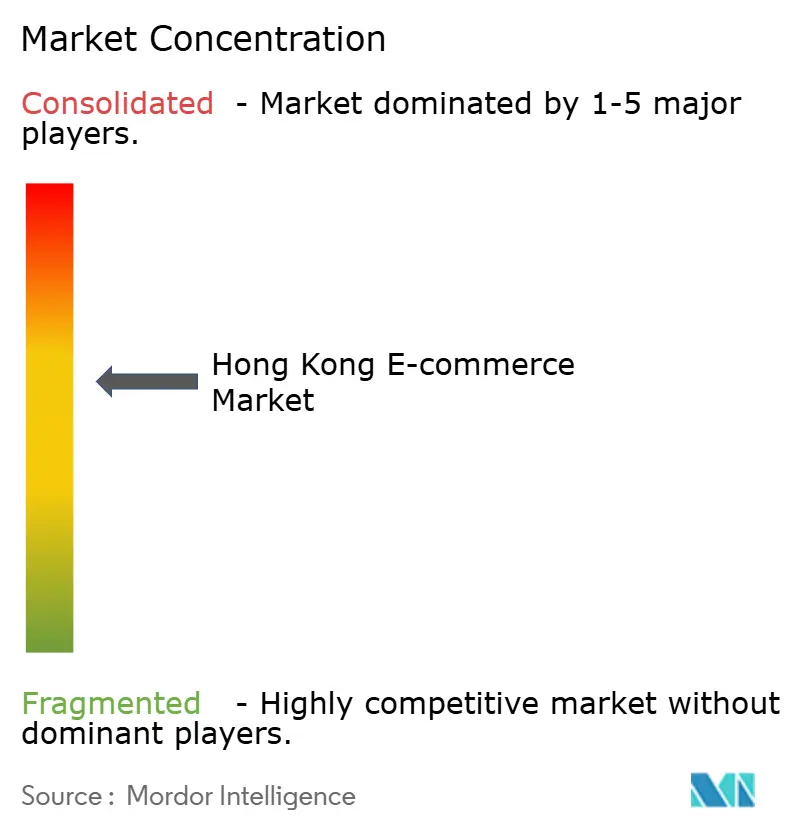
Recent Industry Developments
- May 2025: The Hong Kong government announced plans for a regional cross-border e-commerce logistics hub to boost Greater Bay Area consumption promotion.
- April 2025: The first China–Europe Railway Express E-commerce Express Line commenced operations, running 1-2 trains weekly.
- April 2025: Octopus recorded a 70% year-on-year jump in digital payment transactions during the Easter weekend.
- March 2025: The 2025-26 Hong Kong budget confirmed mid-2025 launch of an instant cross-border small-value remittance service.
Hong Kong E-commerce Market Report Scope
Conducting an e-commerce business means fostering relationships and selling information, services, and goods over computer communication networks. E-commerce usually refers to trading goods and services over the internet, which means broader economic activity. E-commerce consists of B2B and B2C and internal organizational transactions that support these activities.
The study also tracks the key market parameters, underlying growth influencers, and major vendors operating in the industry, which supports the market estimations and growth rates over the forecast period in Hong Kong. The study further analyzes the overall impact of COVID-19 on the ecosystem. The scope of the report encompasses market sizing and forecast for segmentation by B2B and B2C, in which the B2C channel is further segmented by application.
| B2C |
| B2B |
| Smartphone / Mobile |
| Desktop and Laptop |
| Other Device Types |
| Credit / Debit Cards |
| Digital Wallets |
| BNPL |
| Other Payment Method |
| Beauty and Personal Care |
| Consumer Electronics |
| Fashion and Apparel |
| Food and Beverages |
| Furniture and Home |
| Toys, DIY and Media |
| Other Product Categories |
| By Business Model | B2C |
| B2B | |
| By Device Type | Smartphone / Mobile |
| Desktop and Laptop | |
| Other Device Types | |
| By Payment Method | Credit / Debit Cards |
| Digital Wallets | |
| BNPL | |
| Other Payment Method | |
| By B2C Product Category | Beauty and Personal Care |
| Consumer Electronics | |
| Fashion and Apparel | |
| Food and Beverages | |
| Furniture and Home | |
| Toys, DIY and Media | |
| Other Product Categories |
Key Questions Answered in the Report
What is the current value of the Hong Kong e-commerce market?
The Hong Kong e-commerce market is valued at USD 26.15 billion in 2025.
How fast will the market expand over the next five years?
From 2025 to 2030, the market is forecast to grow at a 10.37% CAGR, reaching USD 42.83 billion.
Which segment is growing fastest within the market?
Food & beverages is projected to post the highest 15.5% CAGR in B2C sales through 2030.
Why are digital wallets important for merchants?
Wallets are increasing at 16.3% CAGR and now serve more than 85% of residents, reducing checkout friction and boosting conversion rates.
How significant is cross-border trade for Hong Kong platforms?
Cross-border transactions contribute 55% of total online sales, underlining Hong Kong’s gateway role to mainland China and overseas buyers.
What infrastructure improvements support faster delivery?
Projects such as the China–Europe Railway Express e-commerce line and the Cainiao Smart Gateway shorten transit times and enhance fulfilment efficiency.
Page last updated on:
